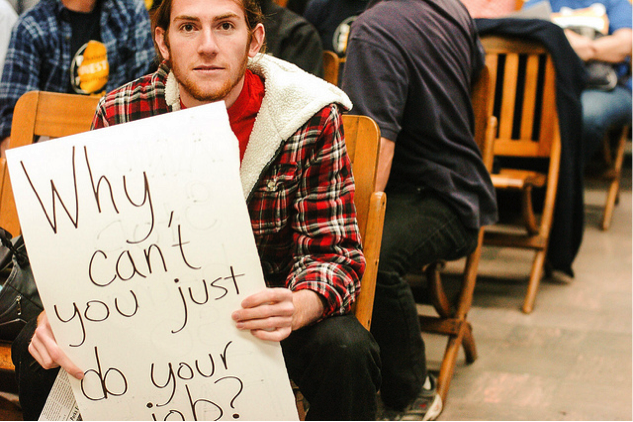Cities Need a New Business Model to Compete in the 21st Century

Who will you meet?
Cities are innovating, companies are pivoting, and start-ups are growing. Like you, every urban practitioner has a remarkable story of insight and challenge from the past year.
Meet these peers and discuss the future of cities in the new Meeting of the Minds Executive Cohort Program. Replace boring virtual summits with facilitated, online, small-group discussions where you can make real connections with extraordinary, like-minded people.
The Business Case for Municipal Management Innovation
When you think of innovation, rarely does the term “municipal government” come to mind. That needs to change if the U.S. hopes to maintain it’s standing as a global economic power. Cities are the main engines of domestic economic output. As a U.S. Conference of Mayors study showed, in 2012, 92% of the jobs added and 89% of growth in real GDP occurred in metro areas. However, major demographic shifts, falling revenues, and rising citizen demands have placed an unprecedented amount of pressure on municipal governments across the U.S.; posing a grave threat to the economic vitality of America’s urban core.
To grapple with these challenges, municipal governments must improve the business model of how they operate. Mayors, city councils, and other municipal elected officials need to embrace the new normal and adopt strategies and frameworks to solve problems that aren’t always politically expedient. Working with their public sector clients, Accenture suggests that:
“Governing in the new normal demands that agencies rethink, reinvent and reinvigorate. This means continually and proactively challenging the status quo in everything they do—from administration and operations to collections and service delivery.”
Thus in the case of cities, the vision set by city leaders does matter. In an analysis of the budgetary decisions facing 13 U.S. cities, IBM found that 30% and 60% of the budget-balancing measures adopted by local governments represented one-time savings or revenue generating measures rather than permanent changes to cost structures. If city leaders adopted a new management approach to identify and root out inefficiencies in their operations, they could shed costs without significantly impacting service levels. Key tools such as participatory budgeting, business process modernization, and technology could all be leveraged to improve the procurement of core services.
Barriers to Success
So what’s holding municipal leaders back?
1. Lack of Public Trust
Across the country, political gridlock and partisanship are at all-time high. Trust in government continues to decline, especially at the local level. According to a 2013 poll conduct by the National League of Cities, only 37% of voters trust their local government. This low level of civic trust makes it increasingly difficult for city leaders to galvanize the public around transformative ideas to drive critical policy outcomes.
2. Federal Disinvestment
Since the end of WWII, urban disinvestment has accelerated and been encouraged by federal policies that promoted suburban flight. This took place simultaneously alongside deindustrialization and automobile-oriented sprawl triggering massive job and population losses. The federal government has the opportunity to play an important role in encouraging cities to be more entrepreneurial in how they govern. By leveraging existing federal resources and encouraging investment into distressed urban areas, the federal government can be a conduit to empower municipal leaders to pursue more innovative policies.
3. Leading with the Wrong Metrics
For most municipal leaders, they judge their success based on traditional measures such as the local unemployment rate, small business starts, and property values. Yet, rarely do we consider the driving forces that impact these metrics. Through their work in understanding community engagement, the Knight Foundation has discovered that attachment to place is driven more by factors such as diversity, community aesthetics, and wealth of social offerings rather than just perceptions of the local economy. If municipal governments developed and articulated their policies with this perspective, they could go a long way in creating more targeted policies aimed at addressing some of the root causes of urban decline.
Translating Better Municipal Management to Greater Urban Economic Opportunity
Putting these ideas into action isn’t a small task. Especially as falling revenues, demographic shifts, rising citizen demands, and new technologies continue to converge to create a complex environment for city leaders. While daunting, city governments can turn these challenges into an opportunity to seek higher performance; which can yield tremendous economic benefits to their citizens.
Specifically, transitioning into a more innovative operating model for municipal government could help create:
- Government-wide collaboration around outcomes
- Flexible and tailored service delivery strategies
- Technology-enabled citizen participation
- Open, transparent and accountable government
Across the country, there are already great models where city leaders are innovating to increase the economic opportunity of their cities. For example, Mayor Mike Bell of Toledo developed a successful public-private partnership with the local chamber of commerce to attract more than $6 million worth of foreign investment, a new metalworking plant, and an additional $200M commitment from Chinese investors to support local economic development efforts. “For little old Podunk, Ohio, it’s been pretty phenomenal what we’ve been able to do,” said Dean Monske, president and chief executive of the Toledo Regional Growth Partnership. In South Bend, Indiana, Mayor Pete Buttigieg worked with a local start-up, called EmNet, to became the first city in the world to migrate its sewer system to the cloud, saving them of $100M in future costs. For Mayor Buttigieg, his philosophy is “all about taking the value of data and shaping them into answers to help solve big problems.”
Through these examples it’s easy to see why now is the right time to develop a renewed commitment to encourage greater innovation in municipal government. Let’s hope American cities don’t get left behind.
Discussion
Leave your comment below, or reply to others.
Please note that this comment section is for thoughtful, on-topic discussions. Admin approval is required for all comments. Your comment may be edited if it contains grammatical errors. Low effort, self-promotional, or impolite comments will be deleted.
2 Comments
Submit a Comment
Read more from MeetingoftheMinds.org
Spotlighting innovations in urban sustainability and connected technology
Middle-Mile Networks: The Middleman of Internet Connectivity
The development of public, open-access middle mile infrastructure can expand internet networks closer to unserved and underserved communities while offering equal opportunity for ISPs to link cost effectively to last mile infrastructure. This strategy would connect more Americans to high-speed internet while also driving down prices by increasing competition among local ISPs.
In addition to potentially helping narrow the digital divide, middle mile infrastructure would also provide backup options for networks if one connection pathway fails, and it would help support regional economic development by connecting businesses.
Wildfire Risk Reduction: Connecting the Dots
One of the most visceral manifestations of the combined problems of urbanization and climate change are the enormous wildfires that engulf areas of the American West. Fire behavior itself is now changing. Over 120 years of well-intentioned fire suppression have created huge reserves of fuel which, when combined with warmer temperatures and drought-dried landscapes, create unstoppable fires that spread with extreme speed, jump fire-breaks, level entire towns, take lives and destroy hundreds of thousands of acres, even in landscapes that are conditioned to employ fire as part of their reproductive cycle.
ARISE-US recently held a very successful symposium, “Wildfire Risk Reduction – Connecting the Dots” for wildfire stakeholders – insurers, US Forest Service, engineers, fire awareness NGOs and others – to discuss the issues and their possible solutions. This article sets out some of the major points to emerge.
Innovating Our Way Out of Crisis
Whether deep freezes in Texas, wildfires in California, hurricanes along the Gulf Coast, or any other calamity, our innovations today will build the reliable, resilient, equitable, and prosperous grid tomorrow. Innovation, in short, combines the dream of what’s possible with the pragmatism of what’s practical. That’s the big-idea, hard-reality approach that helped transform Texas into the world’s energy powerhouse — from oil and gas to zero-emissions wind, sun, and, soon, geothermal.
It’s time to make the production and consumption of energy faster, smarter, cleaner, more resilient, and more efficient. Business leaders, political leaders, the energy sector, and savvy citizens have the power to put investment and practices in place that support a robust energy innovation ecosystem. So, saddle up.










This is a nice article in terms of outlining some key issues. Changing the business model of our local governments and goverance is a huge undertaking that needs to be enabled by enterprise architectures, new and shareable enterprise software architecture and applications. That is exactly what my Smarter Local Government and Cognitive Digital Democracy concepts do.
Traditional approaches to change get inevitably mired in old mind maps and political defensiveness.
As Buckminster Fuller once said (paraphrased): “Don’t change the system. Build a better one”.
I agree with this strategic approach wholeheartedly. And Mark, it would be wonderful to learn more about your products (and concepts). We greatly value ideation above many others at Kade Social Ventures. It’s great that you posted so intelligently and aptly right about the time my company was founded. Hope those concepts are now products and solutions.
It would be wonderful to meet to discuss a few data-driven, metrics based, and smartly strategic value-added as time allows. That is, with whomever runs Meeting of the Minds currently. Kudos on a nice outline and concise, short, really-good read.